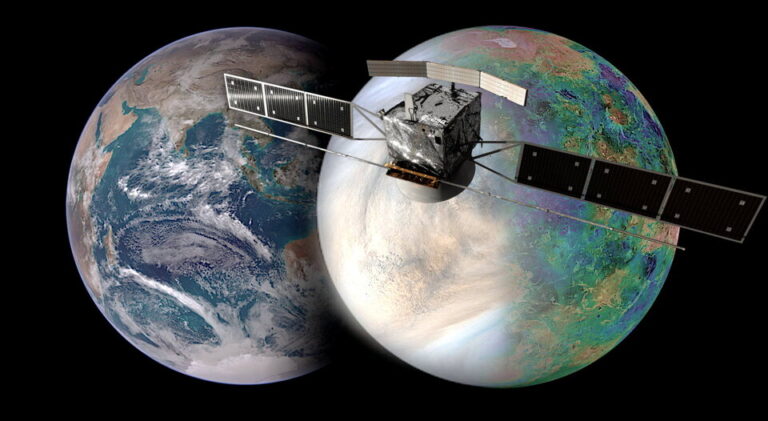The European Space Agency (ESA) has selected EnVision as its next Venus orbiter to provide a holistic view of the planet from its inner core to upper atmosphere to determine how and why Venus and Earth evolved so differently.
The mission was selected by ESA’s Science Programme Committee on June 10 as the fifth Medium-class mission in the Agency’s Cosmic Vision plan, targeting a launch in the early 2030s.
“A new era in the exploration of our closest, yet wildly different, Solar System neighbor awaits us,” said Günther Hasinger, ESA director of science. “Together with the newly announced NASA-led Venus missions, we will have an extremely comprehensive science program at this enigmatic planet well into the next decade.”
EnVision will be equipped with a suite of European instruments including a sounder to reveal underground layering, and spectrometers to study the atmosphere and surface. The spectrometers will monitor trace gases in the atmosphere and analyze surface composition, looking for any changes that might be linked to signs of active volcanism.
A NASA-provided radar will image and map the surface. In addition, a radio science experiment will probe the planet’s internal structure and gravity field as well as investigate the structure and composition of the atmosphere. The instruments will work together to best characterize the interaction between the planet’s different boundaries – from the interior to surface to atmosphere – providing an all-encompassing global view of the planet and its processes.
EnVision follows ESA’s Venus Express (2005-2014), which focused primarily on atmospheric research but which also made dramatic discoveries that pointed to possible volcanic hotspots on the planet’s surface.
JAXA’s Akatsuki spacecraft has also been studying the atmosphere since 2015. EnVision will significantly improve on the radar images of the surface obtained by NASA’s Magellan in the 1990s. Working together with NASA’s upcoming DAVINCI+ (Deep Atmosphere Venus Investigation of Noble gases, Chemistry, and Imaging) and VERITAS (Venus Emissivity, Radio Science, InSAR, Topography, and Spectroscopy) missions, the trio of new spacecraft will provide the most comprehensive study of Venus ever.
The next step for EnVision is to move to the detailed ‘Definition Phase’, in which the design of the satellite and instruments is finalized. Following the design phase, a European industrial contractor will be selected to build and test EnVision before it is launched on an Ariane 6 rocket.
The earliest launch opportunity for EnVision is 2031, with other possible options in 2032 and 2033. The spacecraft would take around 15 months to reach the planet, with a further 16 months to achieve orbit circularization through aerobraking. Its 92-minute orbit will be quasi-polar with an altitude of between 220km and 540km.
This video describes the deployment of EnVision’s instruments VenSAR and SRS, as well as some basic spacecraft operations. VenSAR is a Synthetic Aperture Radar, and will map the surface of Venus using a range of modes including imaging at spatial resolutions of 10m to 30m, altimetry, polarimetry and radiometry.
The Subsurface Sounding Radar (SRS) will penetrate into the top kilometer of the subsurface, and search for underground layering and buried boundaries. Three spectrometers (VenSpec-U, VenSpec-H and VenSpec-M), operating in the ultraviolet and infrared, will map trace gases, including searching for volcanic gas plumes, above and below the clouds, and map surface composition. A gravity and radio science investigation will use radio tracking to map the planet’s gravity field and constraining internal structure, and will measure atmospheric properties through radio occultation.
Video courtesy of European Space Agency / Paris Observatory / VR2Planets



